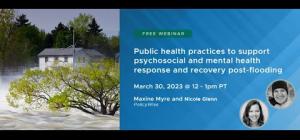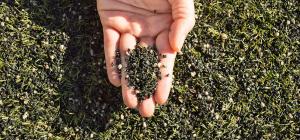
A rapid review of disinfectant chemical exposures and health effects during the COVID-19 pandemic

Primary inquiry
A public health practitioner raised a question about the misuse and overuse of disinfectants as a result of heightened concerns about SARS-CoV-2 transmission via environmental surfaces, and the potential for acute and chronic health impacts due to the use of certain disinfectant products. This document is a rapid review of literature to answer the following questions:
- What are the potential health effects associated with exposure to disinfectants?
- Are there safer substitutions for common disinfectants that have lower risks of long-term adverse health effects?
Disclaimer: The information provided here is for the purpose of addressing a specific inquiry related to an environmental health issue. This is not a comprehensive evidence review. The information offered here does not supersede federal, provincial, or local guidance or regulations.
Methods
A search was conducted in EBSCOhost databases and Google Scholar with variations of the following keywords: (disinfect OR disinfectant OR disinfection OR clean OR cleaning OR cleaner); (asthma OR respiratory OR chronic OR health effects OR health impacts); (sodium hypochlorite OR bleach OR quaternary); (domestic OR home OR house OR occupational OR work). A search for relevant regulations and grey literature was also conducted in Google Search Engine using variations of the above keywords. Only English language articles were included. A perusal of the title and abstract was performed before the article was included for review.
Introduction
The COVID-19 pandemic brought to light the importance of cleaning and disinfecting homes and public settings. Non-pharmaceutical public health measures such as physical distancing, hand hygiene, proper respiratory hygiene/cough etiquette, face coverings, and increased surface cleaning and disinfection have been touted as appropriate interventions against SARS-CoV-2 transmission, especially when used concurrently.
With increased surface cleaning and use of hand sanitizers and disinfection products, there is concern over the risk of misuse and over-exposure to these products. Canadian data showed that between March to June 2020, telephone calls to poison information centres about exposures to hand sanitizers, disinfectants, bleach, chlorine gas, and chloramine gas have increased compared to the same time periods in 2019.1 Data from the US from January to March 2020 showed a sharp increase in the daily number of calls to poison information centres concerning cleaning and disinfection products beginning in March, compared to data from 2018 and 2019.2
How are disinfectants registered and regulated in Canada?
In Canada, surface disinfectants are governed by the Food and Drug Act and evaluated by Health Canada before being assigned a Drug Identification Number (DIN).3–5 This number shows that the product has been evaluated and approved for marketing and sale in Canada.3 Disinfectant registration applications are required to demonstrate efficacy against the microorganisms that the product claims to kill, such as bacteria, fungi, or viruses, and to provide information on surface compatibility and clear usage labels to prevent acute health hazards.6
A comprehensive evaluation of the potential chronic health impacts from exposure to non-food contact disinfectants is not mandatory in Canada.5,6 Toxicological data to support the safety of a product is only required for disinfectants that may come into contact with food.5,6 In the US, the Environmental Protection Agency also reviews the efficacy of disinfectant products against microorganisms that they claim to kill, but does not evaluate all the potential health impacts associated with the active ingredient.7 While Safety Data Sheets provide information on the hazards and safe handling practices for dangerous substances in disinfectant products, additional information on adverse health effects such as sensitizers and allergens may not be readily available or carefully reviewed prior to use by the consumer.8
What are the common active ingredients in disinfectants?
There are several main classes of active ingredients used in disinfectants: bleach, quaternary ammonium compounds, peroxides, chlorine dioxide, citric acid, ethanol, hydrochloric acid, hypochlorous acid, lactic acid, phenols, sodium chlorite, and thymol.9 These chemicals may be used either on their own or in combination to kill or inactivate a variety of microorganisms.9 Of these active ingredients, three main classes of active ingredients are effective against a broad range of pathogenic microorganisms with adequate concentration and contact time: bleach (sodium hypochlorite), peroxides, and quaternary ammonia.9 For more information about disinfectants for use against SARS-CoV-2 and recommendations for concentration and frequency, please consult the NCCEH guidance document, Reducing COVID-19 Transmission Through Cleaning and Disinfecting Household Surfaces.
What are the potential acute and chronic health risks of disinfectants?
Adverse health impacts from exposure to disinfectants can be categorized into acute adverse reactions and chronic health impacts. Acute reactions may be a result of misuse and overuse of disinfectants. Chronic health impacts may be due to long-term exposure to certain chemicals used in disinfectants, whether separately or in combination.
Acute health impacts
According to data from US poison information centres, a sharp increase in total number of calls regarding accidental exposures to cleaners and disinfectants was recorded in March 2020 compared to March 2019.2 A large percentage of total calls was related to exposures among children aged ≤5 years.2 Canadian poison information centres observed the same increase in total number of calls in March 2020, although not the same trend related to children.1 A survey of American adults in May 2020 found knowledge gaps in several areas including safe preparation of disinfectant solutions, use of personal protective equipment while using disinfectants, and safe storage of disinfectant products.10 Some respondents reported using sodium hypochlorite on food items or on hands or skin, misting their bodies with a disinfectant spray, inhalation of disinfectant vapours, and drinking or gargling diluted disinfectant solutions.10
Misuse of disinfectants includes the improper preparation of disinfectant solutions, and the improper mixing of sodium chlorite with other products containing ammonia or acids. Users may be exposed to an excessive concentration of the disinfectant, or dangerous by-products, as a result of chemical reactions caused by improper mixing of products.
Sodium hypochlorite reacts with ammonia, which may be found in cleaning products, glass and window cleaners, urine (potentially in diaper pails, cat litter boxes), and interior and exterior paints, to produce chloramine gases. These gases may cause symptoms including cough, shortness of breath, chest pain, wheezing, nausea, watery eyes, irritation to the throat, nose, and eyes, and/or pneumonia and fluid in the lungs. 11 Chlorine gas is produced when sodium hypochlorite is combined with acids that may be found in cleaning products, automatic dishwasher detergents and rinses, rust removal products, and in lime, calcium, or vinegar. Mixing sodium hypochlorite with hot water also produces chlorine gas. Exposure to low-levels of chlorine gas may cause symptoms including cough, shortness of breath, burning and watery eyes, and runny nose.11 When chlorine gas is combined with water, hydrochloric or hypochlorous acids are formed and can cause burns to the skin, eyes, nose, throat, mouth, and lungs.11 Exposure to high levels of chlorine gas may lead to death.
Overuse of disinfectants includes the excessive use of disinfectants over the recommended frequency, which may lead to overexposure and acute adverse reactions, as well as chronic health impacts as discussed in the following section.
Chronic health impacts
Cleaning agents are often used in conjunction with disinfectant products. Many of these products contain several ingredients (e.g., perfume and other sensitizers) that may also trigger asthma and allergies. This may pose challenges when examining the association between long-term exposure to an individual active ingredient and adverse health outcomes. Health outcomes such as asthma and rhinitis may also be due to exposure to chemical by-products, such as chloramines and chloroform (a known carcinogen), from improperly mixed products.9,12 Other indoor contaminants that may also trigger asthma and other adverse respiratory health outcomes include volatile organic compounds from furniture, carpets, and paint, as well as tobacco smoke, mould, dust, and other allergens and airborne particulates.8,13
Occupational exposure to disinfectant products
A review of epidemiological studies found that there is some evidence of association between exposures to spray disinfectants and asthma symptoms among both professional and non-professional users.14 However, a causal relationship cannot be established. A systematic review of 24 epidemiological studies found that occupational exposure to cleaning and disinfectant products is associated with an increase in the risk of asthma and rhinitis.12 It was found that there is a dose-response relationship between asthma or new-onset asthma and exposure to specific products including ammonia, bleach, chloramines (from mixing bleach with cleaning products) and cleaning sprays.12 An earlier literature review supports the association between exposure to cleaning and disinfectant products and adverse respiratory impacts, exacerbated asthma, and new-onset asthma in cleaning staff, healthcare professionals, and in private homes.15,16 Frequent low-level exposure to irritants including chlorine, ammonia, hydrochloric acid, chloramine, and sodium hydroxide is associated with asthma symptoms.14 Occupational exposure to quaternary ammonium compounds has also been found to increase risk of rhinitis and asthma among healthcare workers.17,18 A literature review of health risks associated with the three most common disinfectant classes (sodium hypochlorite, quaternary ammonium compounds, and peroxides), found that sodium hypochlorite and quaternary ammonium compounds are associated with adverse respiratory health impacts.9 Hydrogen peroxide appears to have low risk at concentrations used in disinfectant products and has not been associated with asthma or nasal irritation.9
Non-occupational exposure in adults
Studies examining the association between domestic use of disinfectants and adverse health effects in adults is limited. A survey of elderly adults found that weekly use of irritating cleaning products, including bleach and ammonia, exhibits a dose-response relationship with asthma symptoms.19 Another large study involving adults from 10 European countries concluded that increased use of bleach in homes is associated with lower rates of allergic reactions to common indoor and outdoor allergens, but higher prevalence of asthma and lower respiratory tract symptoms.20 A study found that frequent use (4-7 days per week) of disinfectants in general (authors did not isolate effects from single disinfectants) was associated with increased risk of asthma in young adults, with some evidence of a dose-response relationship.21 However, low use of disinfectants (1-3 times a week) was associated with a remission of asthma incidence, possibly due to decrease in indoor allergens.21 A study involving various types of domestic cleaning products found that at least once-a-week use of general cleaning sprays, glass-cleaning sprays, furniture sprays, and air-freshening sprays was associated with asthma, but not for bleach or ammonia.22 The reason for this apparent disagreement is unclear, although it may be due to the frequency of use examined in this study, as other studies demonstrated evidence of a dose-response relationship between disinfectant exposure and asthma incidence. Establishing a causal association between exposure and adverse health outcomes is challenging as many studies often group cleaning and disinfectant products together. The use of questionnaires in most studies may be prone to recall bias in the survey respondents.
Indoor exposures in children
Increased use of household disinfectants containing bleach and hydrogen peroxide was found to alter the gut microbiota of infants at 3-4 months of age.23 Overrepresentation of Lachnospiraceae is a strong predictor of higher likelihood of being overweight at age 1 and beyond.23 A study found that after adjusting for exposure to other indoor air contaminants and other confounding factors, children whose mothers more frequently used chemical-based household products during pregnancy were more likely to experience wheeze during early childhood.13 Another study examining children who were passively exposed to bleach as a disinfectant at home and in school found an increased frequency of respiratory symptoms such as respiratory inflammation and recurrent bronchitis, as well as other related infections.24 However, the authors could not confirm whether other indoor contaminants within the homes or the schools acted as confounding factors. Conversely, another study found that cleaning with bleach at least once a week in homes seemed to have a protective effect against the development of asthma in children, possibly due to more effective reduction of indoor allergens and other microbial agents in homes.25 However, this protective effect disappears in children who are also exposed to environmental tobacco smoke, and these children appear to have a higher risk of development recurrent bronchitis.25 It is uncertain what may be the reason for the disagreement among studies. Some possible reasons may be due to differences in frequency of disinfectant use, presence of other indoor contaminants, and recall bias in study participants as many studies relied on questionnaires for data collection, among other reasons.
Does the application method influence the risk of adverse health outcomes?
There are a variety of ways to apply disinfectants. These methods range from manual application with trigger spray bottles to more technologically advanced techniques such as large mechanical sprayers, electrostatic sprayers, and foggers. The technique used depends on many factors, including the type of setting, target surfaces, the intended purpose, size of room or number of surfaces to be treated, and presence of other occupants. Manufacturers of disinfectant products are required to provide clear usage and safety instructions to maximize the effectiveness of disinfection while minimizing harm to users and occupants.
As disinfectants have shown to be associated with adverse respiratory health impacts, application of disinfectants via sprays may facilitate respiratory exposure to airborne particles.26,27 Studies have demonstrated that asthma incidence is associated with the use of cleaning and disinfectant sprays, with limited evidence of a dose-response relationship.14,22,27 While liquid disinfectants may also volatilize, it would depend on the surface being treated, the dilution used, and the ambient temperature.27 The size of particles dispersed via different types of sprayers, ranging from trigger spray bottles, electrostatic sprayers, and foggers differs. Many factors including aerosol size, shape, density, surface characteristics, and evaporation rate dictate how long aerosols stay airborne and where the aerosols eventually deposit in the respiratory tract.26,28,29 As some studies have found a dose-response relationship between exposure to certain disinfectant products and irritation symptoms and asthma, level of exposure may be the main risk factor for adverse health outcomes, especially for domestic cleaning workers in poorly ventilated areas.12
Electrostatic sprayers and disinfectant foggers typically produce smaller droplets compared to handheld trigger sprayers. For a general overview of these types of sprayers, refer to the NCCEH document COVID-19 in indoor environments — Air and surface disinfection measures. Electrostatic sprayers such as the Clorox Total 360 System Electrostatic Sprayer produce droplets ranging from 40-60 µm, while fogging systems may produce droplets as small as 1-10 µm depending on the process used.30,31 Disinfectant fogging machines may be problematic for occupants as the small droplets are able to linger in the air for a prolonged period of time. The use of a disinfectant fogging machine to disinfect ambulances led to complaints of nausea, migraines, headaches, and eye and skin irritation.32 The US CDC does not recommend disinfectant fogging using older machines which use chemicals such as formaldehyde, phenol-based agents, or quaternary ammonium compounds due to ineffectiveness and adverse health effects on workers and other occupants.33 The safety of newer fogging technologies using chemicals such as ozone and vaporized hydrogen peroxide is still being investigated.33
What are some options to lessen unintended health impacts due to disinfectant use?
Surface disinfection is only one of a number of interventions that reduces the transmission risk of pathogenic microorganisms such as SARS-CoV-2. Personal practices such as proper hand hygiene, physical distancing, and wearing face coverings are important non-pharmaceutical interventions to reduce transmission risk, particularly when they are used in combination. Respiratory droplets and aerosols are recognized as the primary transmission route of SARS-CoV-2.34 While fomites may theoretically contribute to the risk of transmission, the evidence to support this pathway is still being investigated. Therefore, the health risks of overexposure to potentially harmful disinfectants should be balanced with the need to prevent viral transmission. Some studies have found a dose-response relationship between disinfectant exposure and asthma incidence. The BC Centre for Disease Control recommends disinfecting high-touch surfaces once every few days if no one in the household has COVID-19 or symptoms of illness.35 This may be adequate to prevent SARS-CoV-2 transmission while reducing the likelihood of adverse health effects from disinfectant exposure.
Prior to implementing a routine disinfection policy, a proper risk assessment should take the following into consideration:36
- Local context and prevalence of the virus
- Characteristics of the setting such as occupancy, and duration and proximity of contact
- Characteristics of the population in the setting
Several recommendations have been suggested in the literature to reduce health risks from disinfectant exposure and improve respiratory health:12,37–39
- Substitute cleaning and disinfectant sprays with liquid products that are manually applied with a cloth
- Substitute sodium hypochlorite and quaternary ammonium compounds with other disinfectants that have lower health risks
- Improve personal protective equipment worn by users
- Increase ventilation during and following treatment
- Follow label usage instructions and avoid mixing cleaning and disinfectant products
- Provide proper worker training in safe cleaning and disinfection practices
- Avoid using cleaning and disinfectant products around children
- Allow the area being treated to air out following application
- Clearly label disinfectants and store away from children and pets
There are organizations in Canada and the US that act as third-party certifiers to identify cleaning and disinfectant products that may be less hazardous to health and more environmentally friendly. These include EcoLogo, Green Seal, and the US EPA’s Design for the Environment program.7,40 Active ingredients in disinfectants that are safer alternatives include caprylic acid, citric acid, hydrogen peroxide, lactic acid, and silver.40 It is important to cross-reference Health Canada’s list of hard-surface disinfectants (COVID-19) to ensure effectiveness against SARS-CoV-2.
Summary
Surface disinfection is one of the interventions that is frequently recommended to reduce the risk of SARS-CoV-2 transmission. However, reports of acute health effects due to misuse and overexposure to disinfectants have been on the rise since early 2020. While businesses and facilities strive to implement more stringent cleaning and disinfection policies, some public health practitioners have raised concerns about the potential of disinfectants to increase the risk of asthma and wheezing. As such, there is merit for public health practitioners to provide clear recommendations about appropriate and safe cleaning and disinfection practices that would protect people from potentially harmful disinfectants while reducing the transmission risk of SARS-CoV-2.
Acknowledgements
The author would like to acknowledge Lydia Ma (NCCEH) for review of this document and valuable feedback, and Michele Wiens for assistance with referencing.
References
- Yasseen A, Weiss D, Remer S, Dobbin N, MacNeill M, Bogeljic B, Leong D, Wan V, Mosher L, Bélair G, Thompson M, Button B, Hardy J, Perwaiz S, Smith A, Wootton R. At-a-glance – Increases in exposure calls related to selected cleaners and disinfectants at the onset of the COVID-19 pandemic: data from Canadian poison centres. 2020. Ottawa, ON: PHAC. Available from: https://www.canada.ca/en/public-health/services/reports-publications/health-promotion-chronic-disease-prevention-canada-research-policy-practice/vol-41-no-1-2021/exposure-cleaners-disinfectants-covid-19-pandemic-canadian-poison-centres.html.
- Chang A, Schnall A, Law R, Bronstein A, Marraffa J, Spiller H, et al. Cleaning and disinfectant chemical exposures and temporal associations with COVID-19 — National Poison Data System, United States, January 1, 2020–March 31, 2020. Morb Mortal Wkly Rep MMWR. 2020;69(16):496–498. Available from: https://www.cdc.gov/mmwr/volumes/69/wr/mm6916e1.htm.
- Health Canada. Drug Identification Number (DIN). 2018. Ottawa, ON: Health Canada. Available from: https://www.canada.ca/en/health-canada/services/drugs-health-products/drug-products/fact-sheets/drug-identification-number.html.
- Health Canada. Guidance documents on disinfectants: summary. 2020. Ottawa, ON: Health Canada. Available from: https://www.canada.ca/en/health-canada/services/drugs-health-products/drug-products/applications-submissions/guidance-documents/disinfectants/summary.html.
- Health Canada. Guidance document: disinfectant drugs (2020). Ottawa, ON: Health Canada. 2020. Available from: https://www.canada.ca/en/health-canada/services/drugs-health-products/drug-products/applications-submissions/guidance-documents/disinfectants/summary.html.
- Health Canada. Guidance document: safety and efficacy requirements for surface disinfectant drugs. Ottawa, ON: Health Canada. 2020. Available from: https://www.canada.ca/en/health-canada/services/drugs-health-products/drug-products/applications-submissions/guidance-documents/disinfectants/summary.html.
- University of California San Francisco Institute for Health & Aging, UC Berkeley Center for Environmental Research and Children’s Health, Informed Green Solutions, California Department of Pesticide Regulation. Green cleaning, sanitizing, and disinfecting: a curriculum for early care and education. San Francisco, CA: University of California, San Francisco School of Nursing; 2013. Available from: https://cerch.berkeley.edu/sites/default/files/green_cleaning_toolkit.pdf.
- Wolkoff P, Schneider T, Kildesø J, Degerth R, Jaroszewski M, Schunk H. Risk in cleaning: chemical and physical exposure. Sci Total Environ. 1998 Apr 23;215(1):135–56. Available from: https://doi.org/10.1016/s0048-9697(98)00110-7.
- Holm S, Leonard V, Durrani T, Miller M. Do we know how best to disinfect child care sites in the United States? A review of available disinfectant efficacy data and health risks of the major disinfectant classes. Am J Infect Control. 2019;47(1):82–91. Available from: https://doi.org/10.1016/j.ajic.2018.06.013.
- Gharpure R, Hunter CM, Schnall AH, Barrett CE, Kirby AE, Kunz J, et al. Knowledge and practices regarding safe household cleaning and disinfection for COVID-19 prevention — United States, May 2020. Morb Mortal Wkly Rep MMWR. 2020;69(23):705–9. Available from: https://www.cdc.gov/mmwr/volumes/69/wr/mm6923e2.htm.
- Chen T. Reducing COVID-19 transmission through cleaning and disinfecting household surfaces. Vancouver, BC: National Collaborating Centre for Environmental Health; 2020. Available from: https://ncceh.ca/documents/guide/reducing-covid-19-transmission-through-cleaning-and-disinfecting-household-surfaces.
- Folletti I, Zock J-P, Moscato G, Siracusa A. Asthma and rhinitis in cleaning workers: a systematic review of epidemiological studies. J Asthma. 2014 Feb 1;51(1):18–28. Available from: https://doi.org/10.3109/02770903.2013.833217.
- Sherriff A, Farrow A, Golding J, Henderson J. Frequent use of chemical household products is associated with persistent wheezing in pre-school age children. Thorax. 2005 Jan 1;60(1):45. Available from: http://thorax.bmj.com/content/60/1/45.abstract.
- Clausen PA, Frederiksen M, Sejbæk CS, Sørli JB, Hougaard KS, Frydendall KB, et al. Chemicals inhaled from spray cleaning and disinfection products and their respiratory effects. A comprehensive review. Int J Hyg Environ Health. 2020 Aug 1;229:113592. Available from: https://doi.org/10.1016/j.ijheh.2020.113592.
- Vandenplas O, Wiszniewska M, Raulf M, de Blay F, Gerth van Wijk R, Moscato G, et al. EAACI position paper: irritant-induced asthma. Allergy. 2014 Sep ;69(9):1141–53. Available from: https://doi.org/10.1111/all.12448.
- Zock J-P, Vizcaya D, Le Moual N. Update on asthma and cleaners. Curr Opin Allergy Clin Immunol. 2010 Apr;10(2):114–20. Available from: https://doi.org/10.1097/aci.0b013e32833733fe.
- Gonzalez M, Jégu J, Kopferschmitt M-C, Donnay C, Hedelin G, Matzinger F, et al. Asthma among workers in healthcare settings: role of disinfection with quaternary ammonium compounds. Clin Exp Allergy. 2014 Mar;44(3):393–406. Available from: https://doi.org/10.1111/cea.12215.
- Mirabelli MC, Zock J-P, Plana E, Antó JM, Benke G, Blanc PD, et al. Occupational risk factors for asthma among nurses and related healthcare professionals in an international study. Occup Environ Med. 2007 Jul 1;64(7):474. Available from: http://oem.bmj.com/content/64/7/474.abstract.
- Lemire P, Dumas O, Chanoine S, Temam S, Severi G, Boutron-Ruault M-C, et al. Domestic exposure to irritant cleaning agents and asthma in women. Environ Int. 2020 Nov 1;144:106017. Available from: https://erj.ersjournals.com/content/52/suppl_62/PA3919.
- Zock J-P, Plana E, Antó JM, Benke G, Blanc PD, Carosso A, et al. Domestic use of hypochlorite bleach, atopic sensitization, and respiratory symptoms in adults. J Allergy Clin Immunol. 2009 Oct 1;124(4):731-738.e1. Available from: https://doi.org/10.1016/j.jaci.2009.06.007.
- Weinmann T, Gerlich J, Heinrich S, Nowak D, Mutius E von, Vogelberg C, et al. Association of household cleaning agents and disinfectants with asthma in young German adults. Occup Environ Med. 2017 Sep 1;74(9):684. Available from: http://oem.bmj.com/content/74/9/684.abstract.
- Zock J-P, Plana E, Jarvis D, Antó JM, Kromhout H, Kennedy SM, et al. The use of household cleaning sprays and adult asthma: an international longitudinal study. Am J Respir Crit Care Med. 2007 Oct 15;176(8):735–41. Available from: https://doi.org/10.1164/rccm.200612-1793oc.
- Tun MH, Tun HM, Mahoney JJ, Konya TB, Guttman DS, Becker AB, et al. Postnatal exposure to household disinfectants, infant gut microbiota and subsequent risk of overweight in children. CMAJ. 2018 Sep;190(37):E1097–107. Available from: https://www.cmaj.ca/content/190/37/E1097.
- Casas L, Espinosa A, Borràs-Santos A, Jacobs J, Krop E, Heederik D, et al. Domestic use of bleach and infections in children: a multicentre cross-sectional study. Occup Environ Med. 2015 Aug 1;72(8):602. Available from: http://oem.bmj.com/content/72/8/602.abstract.
- Nickmilder M, Carbonnelle S, Bernard A. House cleaning with chlorine bleach and the risks of allergic and respiratory diseases in children. Pediatr Allergy Immunol. 2007;18(1):27–35. Available from: https://doi.org/10.1111/j.1399-3038.2006.00487.x.
- Lovén K, Isaxon C, Wierzbicka A, Gudmundsson A. Characterization of airborne particles from cleaning sprays and their corresponding respiratory deposition fractions. J Occup Environ Hyg. 2019 Sep 2;16(9):656–67. Available from: https://doi.org/10.1080/15459624.2019.1643466.
- Zock J-P, Plana E, Jarvis D, Antó JM, Kromhout H, Kennedy SM, et al. The use of household cleaning sprays and adult asthma. Am J Respir Crit Care Med. 2007 Oct 15;176(8):735–41. Available from: https://doi.org/10.1164/rccm.200612-1793OC.
- Jabbal S, Poli G, Lipworth B. Does size really matter?: Relationship of particle size to lung deposition and exhaled fraction. J Allergy Clin Immunol. 2017;139(6):2013–4. Available from: https://www.jacionline.org/article/S0091-6749(17)30005-2/fulltext.
- Tsuda A, Henry FS, Butler JP. Particle transport and deposition: basic physics of particle kinetics. Compr Physiol. 2013 Oct;3(4):1437–71. Available from: https://dx.doi.org/10.1002%2Fcphy.c100085.
- Cadnum JL, Jencson AL, Livingston SH, Li DF, Redmond SN, Pearlmutter B, et al. Evaluation of an electrostatic spray disinfectant technology for rapid decontamination of portable equipment and large open areas in the era of SARS-CoV-2. Am J Infect Control. 2020 Aug;48(8):951–4. Available from: https://dx.doi.org/10.1016%2Fj.ajic.2020.06.002.
- Chen T, O’Keeffe J. COVID-19 in indoor environments — Air and surface disinfection measures. Vancouver, BC: National Collaborating Centre for Environmental Health; 2020. Available from: https://ncceh.ca/documents/guide/covid-19-indoor-environments-air-and-surface-disinfection-measures.
- Palmer J. Disinfectant fog is not your friend. OSHA Healthcare Advisor. 2010. Available from: http://blogs.hcpro.com/osha/2010/12/disinfectant-fog-is-not-your-friend/.
- US Centers for Disease Control and Prevention. Guideline for disinfection and sterilization in healthcare facilities (2008): recommendations for disinfection and sterilization in healthcare facilities. Atlanta, GA: CDC. 2019. Available from: https://www.cdc.gov/infectioncontrol/guidelines/disinfection/recommendations.html.
- O'Keeffe J, Freeman S, Nicol AM. An Introduction to SARS-CoV-2. Vancouver, BC: National Collaborating Centre for Environmental Health; 2020 May. Available from: https://ncceh.ca/documents/evidence-review/introduction-sars-cov-2.
- British Columbia Centre for Disease Control. Cleaning and disinfecting. Vancouver, BC: BCCDC. 2020 [cited 2020 Oct 22]. Available from: http://www.bccdc.ca/health-info/diseases-conditions/covid-19/prevention-risks/cleaning-and-disinfecting.
- Public Health Agency of Canada. Community-based measures to mitigate the spread of coronavirus disease (COVID-19) in Canada. Ottawa, ON: PHAC. 2020. Available from: https://www.canada.ca/en/public-health/services/diseases/2019-novel-coronavirus-infection/health-professionals/public-health-measures-mitigate-covid-19.html.
- University of Washington Department of Environmental & Occupational Health Sciences, School of Public Health. Safer cleaning, sanitizing and disinfecting strategies to reduce and prevent COVID-19 transmission. Seattle, WA: University of Washington; n.d. Available from: https://osha.washington.edu/sites/default/files/documents/FactSheet_Cleaning_Final_UWDEOHS_0.pdf.
- Shrem D, Weinberg J, Flattery J. Healthy cleaning & asthma-safer schools: a how-to guide. Sacramento, CA: California Department of Public Health; 2014. Available from: https://www.cdph.ca.gov/Programs/CCDPHP/DEODC/OHB/WRAPP/Pages/CLASS-Guide.aspx.
- Takaro TK, Parks J. RE: Association of use of cleaning products with respiratory health in a Canadian birth cohort. Can Med Assoc J. 2020 Mar; Available from: https://www.cmaj.ca/content/re-association-use-cleaning-products-respiratory-health-canadian-birth-cohort.
- Culver A, Geiger C, Simon D. Safer products and practices for disinfecting and sanitizing surfaces. San Francisco, CA: San Francisco Department of the Environment; 2014. Available from: https://sfenvironment.org/download/safer-products-and-practices-for-disinfecting-surfaces.








